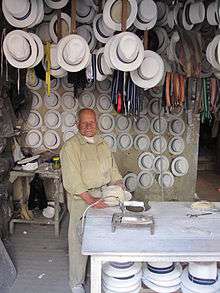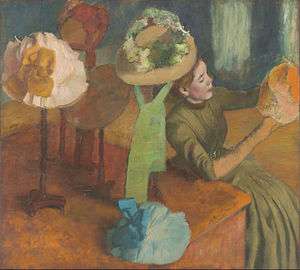Hatmaking

.jpg)
Hatmaking or millinery is the design, manufacture and sale of hats and head-wear. A person engaged in this trade is called a milliner or hatter.
Millinery is sold to women, men and children, though some definitions limit the term to women's hats.[1] Historically, milliners, typically female shopkeepers, produced or imported an inventory of garments for men, women, and children, and sold these garments in their millinery shop. More recently, the term milliner has evolved to describe a person who designs, makes, sells or trims hats primarily for a female clientele. The origin of the term is probably the Middle English milener, meaning an inhabitant of the city of Milan or one who deals in items from Milan,[2] known for its fashion and clothing.
Types
Many styles of headgear have been popular through history and worn for different functions and events. They can be part of uniforms or worn to indicate social status. Styles include the top hat, hats worn as part of military uniforms, fedora, cowboy hat, and cocktail hat.
Women's hats
A great variety of objects are or formerly were used as trimmings on women's fashionable hats: see Trim (sewing)#See also.
In former times excessive use of colorful bird feathers and wings and tails and whole stuffed birds as hat trimmings led to the formation of the Royal Society for the Protection of Birds (RSPB).
- Google search for images of hats trimmed with birds
- Link to images and descriptions of hats trimmed with birds
This link, with references to 1880s newspaper issues, describes as ornaments on fashionable hats, bird feathers, and stuffed birds and other small animals, and fruit, flowers, ribbons and lace. It says that in 1889 in London and Paris, over 8,000 women were employed in millinery, and in 1900 in New York, some 83,000 people, mostly women. It also described a fashion for stuffed kittens' heads as hat ornaments in or around 1883 in Paris (France), often posed looking out from among foliage and feathers, to the point where some people were reported to breed kittens for the millinery trade.[3]
Notable hatters and milliners
This is a partial list of people who have had a significant influence on hatmaking and millinery.
Hatters
- International Hat Company, an American manufacturer credited with inventing one of America's most popular early 20th century harvest hats for field hands, farmers, and workmen.
- Hawley Products Company, an American manufacturer credited with inventing the tropical shaped, pressed fiber sun helmet used from World War II through the Persian Gulf War.
- John Cavanagh, an American hatter whose innovations included manufacturing regular, long and wide-oval fitting hats to enable customers to find better-fitting ready-to-wear hats.
- James Lock & Co. of London (founded 1676), is credited with the introduction of the bowler hat in 1849.[4]
- John Batterson Stetson, credited with inventing the classic cowboy hat[5]
- Giuseppe Borsalino, with the famous "Borsalino" Fedora hat.
Milliners

- Anna Ben-Yusuf wrote The Art of Millinery (1909), one of the first reference books on millinery technique.[6]
- Rose Bertin, milliner and modiste to Marie Antoinette, is often described as the world's first celebrity fashion designer.[7]
- John Boyd was one of London's most respected milliners and is known for the famous pink tricorn hat worn by Diana, Princess of Wales.[8]
- Lilly Daché was a famous American milliner of the mid-20th century.
- Frederick Fox was an Australian born milliner noted for his designs for the British Royal family.
- Mr. John was an American milliner considered by some to be the millinery equivalent of Dior in the 1940s and 1950s.[9]
- Stephen Jones of London, is considered one of the world's most radical and important milliners of the late 20th and early 21st centuries.[10]
- Simone Mirman was known for her designs for Elizabeth II and other members of the British Royal Family.
- Barbara Pauli was the leading fashion milliner and modiste in Sweden during the Gustavian era.
- Caroline Reboux was a renowned milliner of the 19th and early 20th centuries.
- David Shilling is a renowned milliner, artist and designer based in Monaco.[11]
- Justin Smith is an award-winning milliner creating bespoke and couture hats under the J Smith Esquire brand.
- Philip Treacy Irish-born award-winning milliner; first milliner for 80 years to be invited to exhibit at the Paris haute couture shows.[12]
See also
References
- ↑ "Milliner". Merriam-Webster. Retrieved 2012-06-07.
- ↑ American Heritage Dictionary of the English Language, Third Edition
- ↑ "WHEN KITTENS' HEAD HATS WERE ALL THE RAGE". messybeast.com.
- ↑ Bowler hat makes a comeback Telegraph (London). Retrieved 9 June 2012
- ↑ Reynolds, William and Rich Rand (1995) The Cowboy Hat book. Pg 8 ISBN 0-87905-656-8
- ↑ Jones, Stephen & Cullen, Oriole (editor) (2009). Hats: An Anthology. V&A Publishing. ISBN 1-85177-557-9.
- ↑ Steele, Valerie (2010). The Berg Companion to Fashion. Berg. pp. 72–73. ISBN 1847885926. Retrieved 9 June 2012.
- ↑ "John Boyd". The FMD - FashionModelDirectory.com.
- ↑ "Mr. John, 91, Hat Designer for Stars and Society". 29 June 1993.
- ↑ Biography of Stephen Jones on the V&A Museum website, accessed 1 April 2009
- ↑ Hillier, Bevis (13 October 1985). "Hat Trick". LA Times. Retrieved 24 January 2013.
- ↑ Jess Cartner-Morley (16 April 2002). "Who wants to be a milliner". The Guardian.
He has created hats to accompany the catwalk collections of Alexander McQueen and Valentino, has been named British Accessory Designer of the Year five times, and was the first milliner in 80 years to be invited by French fashion's governing body, the Chambre Syndicale, to take part in the Parisian haute couture shows
External links
- All Sewn Up: Millinery, Dressmaking, Clothing and Costume
- 18th Century millinery
- Popular Science, November 1941, "Pulling Hats Out Of Rabbits" article on modern mass production hat making
- Individuality in millinery, a 1923 book on hatmaking from The Metropolitan Museum of Art Libraries (fully available online as PDF)
- Millinery guide (UK)